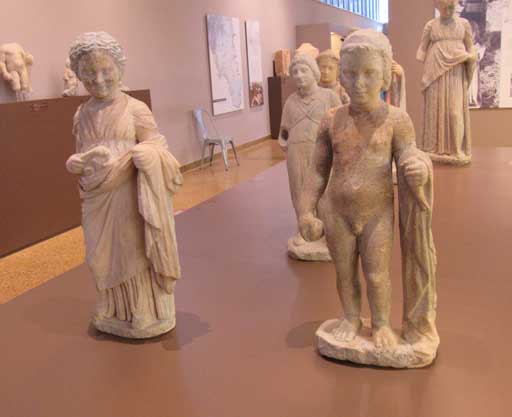Greek religion was weird. It was a mashup consisting of various local traditions shoe-horned together, with myths having many variations depending on who you asked, and even the nature of the gods seemed somewhat protean, with very different versions of a god being worshiped in different places. The cult statue of Artemis worshiped in Ephesus doesn’t much look like the typical image of Artemis from the Greek mainland, though both feature wildlife. Artemis was both a protector of wild animals and a huntress, the goddess both of chastity and childbirth, and both gave and relieved diseases in women.
People seemed not to have been interested in the myths’ contradictions, they just picked the story they liked. Christianity, by contrast, has been trying to settle doctrine for nearly two thousand years, and has produced a body of doctrine people can accept or reject, according to their inclinations.
Here is the sanctuary of Artemis at Brauron, south of Athens. It’s larger than it looks in the photograph, with ruins sprawling over quite a few hectares. They include apartments with stone tables and seats still in place, apparently used during the time of the Brauronia pilgrimage.
But first there’s Iphigenia! According to one version of the myth, Artemis took exception to Agamemnon’s killing some sacred stags, and cursed the Greek army bound for Troy, stranding them at Aulis. Agamemnon summoned his daughter Iphigenia to Aulis, then had her seized and gagged and prepared for sacrifice to appease the goddess. Iphigenia slipped out of her saffron robes and begged for mercy (presumably in dumbshow), but she was carried to the altar anyway. Just in time, Artemis rescued Iphigenia and substituted an animal, which was duly sacrificed. Artemis carried Iphigenia to Brauron, where she lived as an acolyte and died. Her tomb was located in the sanctuary.
The festival of the Brauronia took place every four or five years, depending on your source, and involved a pilgrimage from Athens of young girls of around 10 years of age. Originally the girls were dressed in bear skins, but as bears became scarce in Attica, the skins were replaced by the saffron robes of Iphigenia. As part of the ritual, the girls (known as Arctoi, little bears) shed their robes and performed a clomping bear dance meant to imitate the slow, deliberate movements of a bear.
There were other bits of ceremony connected with the pilgrimage, all of which are subject to debate by scholars. One plausible theory states that the ceremony was intended to appease Artemis and gain her protection, until the girls shed their wild state and transitioned to marriage and childbirth.
Or it means something else entirely. Take your pick.
Another legend involving Artemis and bears concerns the nymph Callisto (‘the prettiest’), after whom our little excursion vessel was named. Callisto was a devotee of Artemis until she got raped by Zeus, who was possibly disguised as Apollo or as Artemis herself. When Callisto got pregnant, Artemis participated in the well-established tradition of Blaming the Victim. (“She must have dressed provocatively, otherwise Daddy wouldn’t even have noticed her.”) Callisto was transformed into a bear, and her son Arcas (who remained human) was fostered out. Callisto entered the forbidden precincts of a temple of Zeus, I suppose to ask her boyfriend’s aid, and was on the verge of being killed by grownup Arcas (who didn’t recognize her), when Artemis apparently decided this was getting far too absurd, and put Callisto and Arcas into the sky as the Big and Little Bear.
Other versions have Zeus turning mother and son into constellations, or Hera turning Callisto into a bear in vengeance, or Artemis killing Callisto with an arrow. Whatever you like!
Even when detailed descriptions of rituals and suchlike exist, or coherent versions of the myths, they exist mainly as grounds for debate by scholars.
Or as ample fodder for writers. Wild bear girls! Someone’s gotta use that.



Yet another version puts Iphigenia in Brooklyn, but that may not be canon.
Comments on this entry are closed.